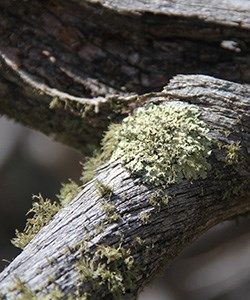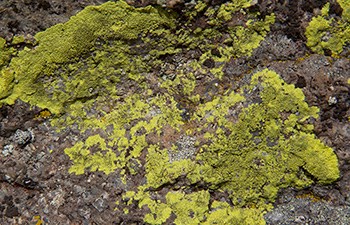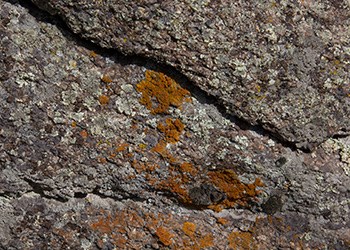
NPS / Joe Bruce A lichen is a combination of two orgranisms supporting each other. The primary structure is created by a fungus, which hosts an algae that produces food through photosynthesis. This relationship is known as symbiosis. The connections between the fungi and the alga are often mutualistic, meaning the organisms beneift each other. That relationship varies with the lichen species: while the algae can often survive independent of the host fungus, the fungus is dependent on the algae. This creates a parasitic relationship between the two organisms. Regardless of the type of relationship, the result is a fascinating and diverse group of organisms that grow in practically every outdoor environment on the planet. 
NPS / Avery Locklear Why is the Tower Green?Although lichens come in a variety of forms and colors, green is most common at Devils Tower. Looking up at the formation, many visitors notice a distinctive green color on the rock. These are the many lichens which cover Devils Tower. The color of lichens can change or become more vibrant when exposed to water (i.e. rainfall). Lichens are found on many of the rocks in the park, and can also grow on plants or soil. Although there are numerous types of lichen growth forms, crustose is the most common at Devils Tower National Monument. These lichens adhere tightly to the rock, appearing like a thick coat of paint on its surface. Other lichens here are foliose, which have flat, leaf-like lobes slightly elevated from the rock or surface where it lives.
NPS / Avery Locklear LichenometryLichens generally have a slow and regular growth rate. Because of this and their long life span, they are sometimes used to date exposed rock. This process, known as lichenometry, is most accurate for surfaces exposed less than 1,000 years. Therefore, lichenometry is not a reliable tool to answer a common question about Devils Tower: when was the last major rock fall? There are extensive lichens on both the Tower and the boulders around its base, some of which are likely hundreds, if not thousands, of years old. Although they may provide some context for erosion of the Tower rock, lichens cannot definitively answer when a column fell.Environmental IndicatorsSome species of lichens are very sensitive to air pollution and other environmental factors. They serve as indicators of overall ecosystem health. Since lichens can grow in places where nothing else can, they are a pioneer species. In some habitats, plants depend on lichens to colonize an area and stabilize soils before they can grow. At Devils Tower, lichens also contribute to the weathering of the rock. Acids which can break down minerals are created by lichens, which slowly weathers the rock where it grows. |
Last updated: April 24, 2025
